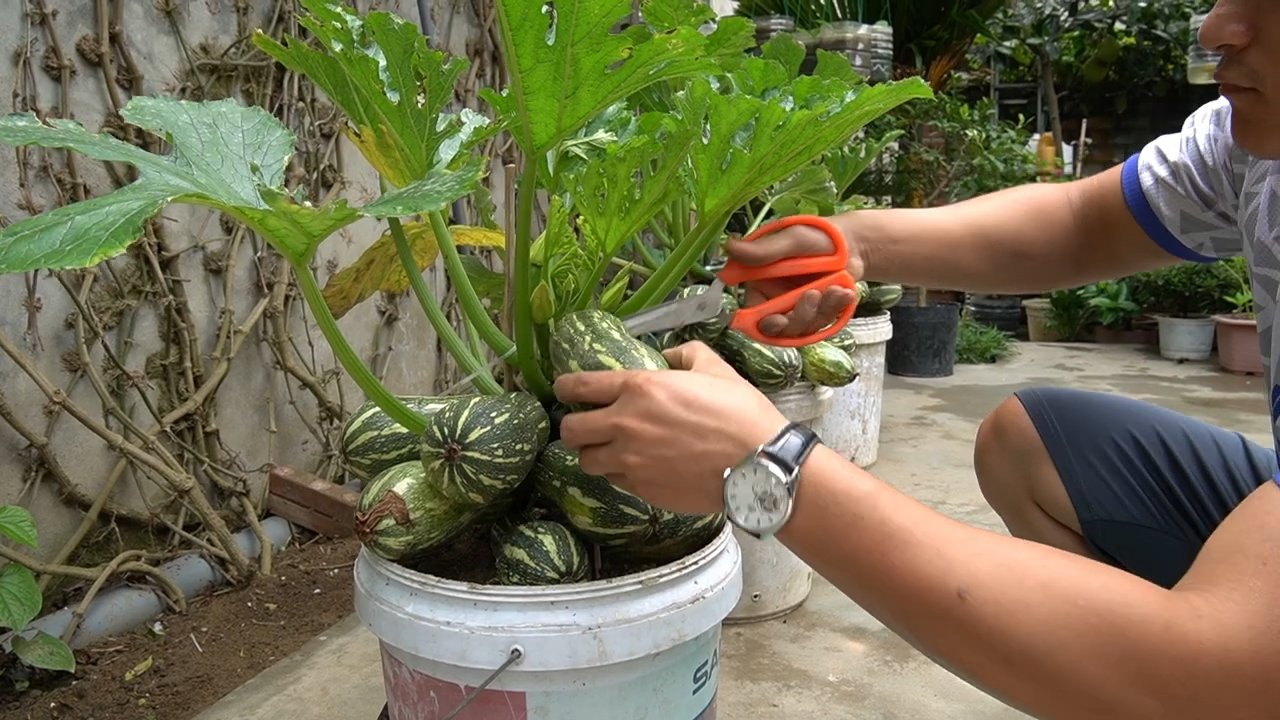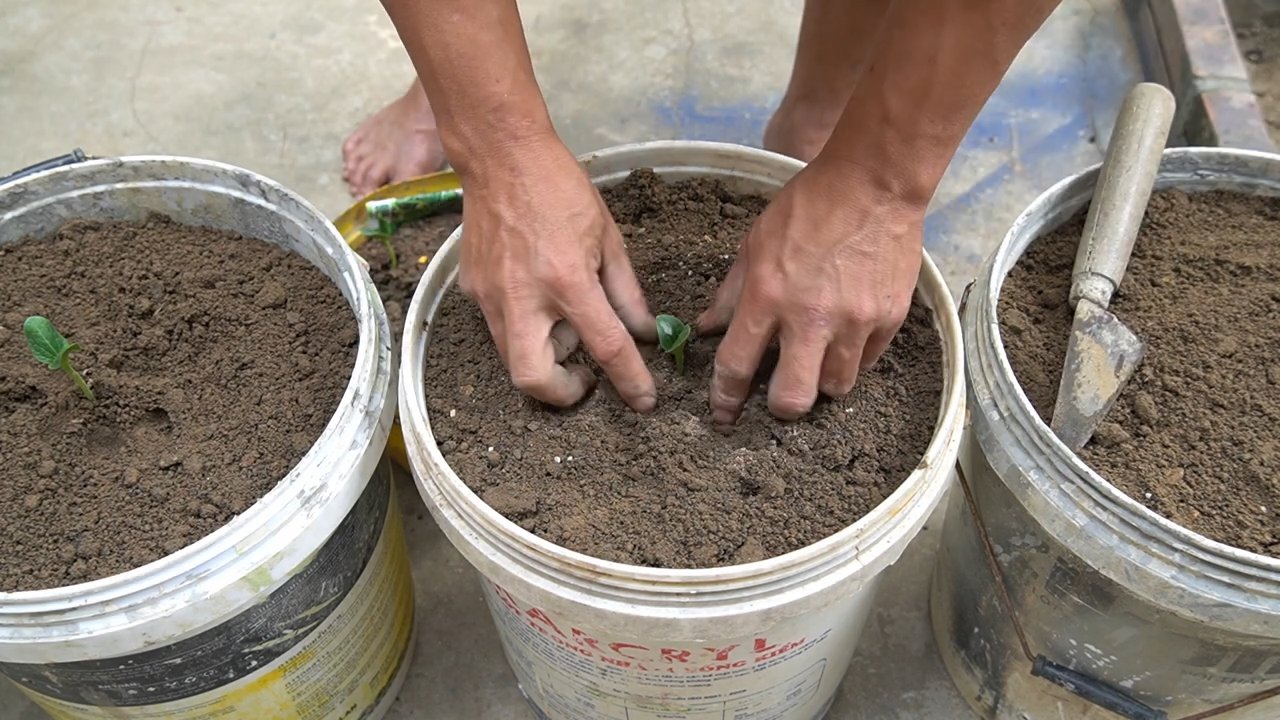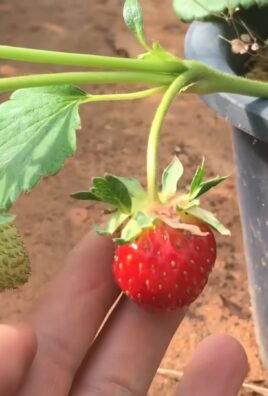Zucchini growing setup at home doesn’t have to be intimidating! Have you ever dreamed of stepping into your backyard and harvesting fresh, vibrant zucchini for a delicious summer meal? I know I have! But the thought of setting everything up can feel overwhelming, right? Well, fear not, because this guide is packed with easy-to-follow DIY tricks and hacks that will transform your garden (or even your balcony!) into a zucchini paradise.
For centuries, cultivating your own food has been a deeply rewarding practice. From ancient civilizations nurturing their crops to modern-day gardeners embracing sustainable living, the connection between humans and the earth is undeniable. Growing zucchini, in particular, offers a unique satisfaction. These prolific plants are known for their generous yields, making them a fantastic choice for beginner gardeners and seasoned pros alike.
But let’s be honest, sometimes getting started is the hardest part. Maybe you’re short on space, or perhaps you’re unsure about the best soil conditions. That’s where these DIY tricks come in! I’m going to share my favorite tips and tricks for creating the perfect zucchini growing setup at home, regardless of your experience level or garden size. We’ll cover everything from choosing the right container to maximizing sunlight exposure, ensuring you’ll be harvesting baskets full of zucchini in no time. Get ready to unleash your inner gardener and enjoy the delicious rewards of your labor!

Growing Zucchini at Home: A DIY Guide for Bountiful Harvests
Hey there, fellow gardening enthusiasts! I’m so excited to share my tried-and-true method for growing zucchini right in your own backyard (or even on a balcony!). Zucchini is a fantastic vegetable to grow – it’s prolific, relatively easy, and incredibly versatile in the kitchen. Get ready for a summer filled with zucchini bread, grilled zucchini, and so much more!
Choosing Your Zucchini Variety
Before we dive into the nitty-gritty, let’s talk about zucchini varieties. There are tons of options, each with its own unique characteristics. Here are a few of my favorites:
* Black Beauty: This is a classic, reliable variety that produces dark green, almost black, zucchini. It’s known for its excellent flavor and productivity.
* Costata Romanesco: If you’re looking for something a little different, this Italian heirloom variety is a great choice. It has ribbed, light green fruit with a nutty flavor.
* Golden Zucchini: For a pop of color in your garden, try growing golden zucchini. These bright yellow fruits are just as delicious as their green counterparts.
* Round Zucchini (Eight Ball, One Ball): These are perfect for stuffing! They are compact and produce round, ball-shaped zucchini.
Preparing Your Zucchini Growing Space
Zucchini plants need plenty of sunlight and well-drained soil to thrive. Here’s how I prepare my growing space:
* Sunlight: Zucchini needs at least 6-8 hours of direct sunlight per day. Choose a location in your garden that gets plenty of sun.
* Soil: Zucchini prefers well-drained, fertile soil with a pH between 6.0 and 7.5. Amend your soil with compost or other organic matter to improve drainage and fertility.
* Space: Zucchini plants can get quite large, so give them plenty of space to grow. I recommend spacing plants at least 2-3 feet apart. If you’re growing in containers, choose a large pot that’s at least 18 inches in diameter.
* Support (Optional): While not always necessary, providing support for your zucchini plants can help keep the fruits off the ground and prevent rot. You can use a trellis, stake, or tomato cage.
Step-by-Step Planting Guide
Now for the fun part – planting your zucchini! I usually start my seeds indoors a few weeks before the last expected frost, but you can also direct sow them in the garden once the soil has warmed up.
Starting Seeds Indoors (Optional)
1. Gather Your Supplies: You’ll need zucchini seeds, seed starting trays or small pots, seed starting mix, and a spray bottle.
2. Sow the Seeds: Fill your seed starting trays or pots with seed starting mix. Make a small hole (about 1 inch deep) in the center of each cell or pot. Place one or two zucchini seeds in each hole and cover with soil.
3. Water Gently: Use a spray bottle to gently water the soil. You want to keep the soil moist but not soggy.
4. Provide Warmth and Light: Place the seed starting trays or pots in a warm location (around 70-75°F) and provide plenty of light. You can use a heat mat to warm the soil and a grow light to supplement natural sunlight.
5. Transplant Seedlings: Once the seedlings have developed a few sets of true leaves (usually after 2-3 weeks), they’re ready to be transplanted into the garden. Harden them off by gradually exposing them to outdoor conditions for a week before transplanting.
Direct Sowing Seeds in the Garden
1. Prepare the Soil: Clear the planting area of any weeds or debris. Amend the soil with compost or other organic matter.
2. Sow the Seeds: Make small mounds of soil about 2-3 feet apart. Plant 2-3 zucchini seeds in each mound, about 1 inch deep.
3. Water Gently: Water the soil gently to keep it moist.
4. Thin Seedlings: Once the seedlings emerge, thin them to one plant per mound. Choose the strongest, healthiest seedling and remove the others.
Caring for Your Zucchini Plants
Once your zucchini plants are established, it’s important to provide them with proper care to ensure a bountiful harvest.
Watering
Zucchini plants need consistent moisture, especially during hot, dry weather. Water deeply and regularly, aiming to keep the soil consistently moist but not waterlogged. I usually water my plants in the morning to allow the foliage to dry before nightfall, which helps prevent fungal diseases.
Fertilizing
Zucchini plants are heavy feeders, so it’s important to fertilize them regularly. I like to use a balanced fertilizer (such as 10-10-10) every few weeks. You can also side-dress your plants with compost or other organic matter.
Weeding
Keep the area around your zucchini plants free of weeds. Weeds compete with zucchini plants for water and nutrients. I usually hand-pull weeds or use a hoe to cultivate the soil.
Pest and Disease Control
Zucchini plants can be susceptible to a few pests and diseases. Here are some common problems and how to deal with them:
* Squash Vine Borers: These pests can tunnel into the stems of zucchini plants and kill them. To prevent squash vine borers, wrap the base of the stems with aluminum foil or netting. You can also use an insecticide specifically designed for squash vine borers.
* Powdery Mildew: This fungal disease can cause a white, powdery coating on the leaves of zucchini plants. To prevent powdery mildew, provide good air circulation and avoid overhead watering. You can also use a fungicide specifically designed for powdery mildew.
* Squash Bugs: These pests can suck the sap from zucchini plants and cause them to wilt and die. To control squash bugs, hand-pick them off the plants or use an insecticide specifically designed for squash bugs.
* Aphids: These small insects can cluster on the undersides of leaves and suck the sap from zucchini plants. A strong blast of water from a hose can often dislodge them. Insecticidal soap is also effective.
Pollination
Zucchini plants have separate male and female flowers. The female flowers need to be pollinated in order to produce fruit. Bees and other pollinators usually do the job, but sometimes you may need to hand-pollinate the flowers yourself.
Hand-Pollination (If Needed)
1. Identify Male and Female Flowers: Male flowers have a long, thin stem, while female flowers have a small zucchini fruit at the base.
2. Collect Pollen: Use a small paintbrush or cotton swab to collect pollen from the male flower.
3. Transfer Pollen: Gently transfer the pollen to the stigma (the center part) of the female flower.
4. Repeat: Repeat this process for all the female flowers that you want to pollinate.
Harvesting Your Zucchini
Zucchini is usually ready to harvest about 50-60 days after planting. The fruits should be firm and tender, and about 6-8 inches long. Don’t let them get too big, as they can become tough and seedy.
* Harvest Regularly: Harvest your zucchini regularly to encourage the plant to produce more fruit.
* Cut the Stem: Use a sharp knife or pruning shears to cut the stem of the zucchini fruit, leaving about 2 inches of stem attached.
* Store Properly: Store zucchini in the refrigerator for up to a week.
Dealing with Overabundance
Let’s be honest, zucchini plants are incredibly productive. You might find yourself with more zucchini than you know what to do with! Here are some ideas for using up your zucchini harvest:
* Zucchini Bread: This is a classic way to use up zucchini. There are tons of recipes online.
* Grilled Zucchini: Slice zucchini into planks and grill them with olive oil, salt, and pepper.
* Zucchini Noodles (Zoodles): Use a spiralizer to turn zucchini into noodles. Serve them with your favorite sauce.
* Zucchini Fritters: Grate zucchini and mix it with flour, eggs, and seasonings. Fry the mixture in oil until golden brown.
* Zucchini Soup: Make a creamy zucchini soup with onions, garlic, and vegetable broth.
* Zucchini Relish: Preserve your zucchini harvest by making a relish.
* Share with Friends and Neighbors: Spread the zucchini love! Your friends and neighbors will appreciate your generosity.
Troubleshooting Common Zucchini Problems
Even with the best care, you might encounter some problems while growing zucchini. Here are some common issues and how to address them:
* Blossom End Rot: This condition causes the blossom end of the zucchini fruit to rot. It’s usually caused by a calcium deficiency. To prevent

Conclusion
So, there you have it! Transforming your backyard (or even a sunny balcony) into a thriving zucchini patch is not only achievable but incredibly rewarding. We’ve walked you through the simple steps to create your own DIY zucchini growing setup at home, and hopefully, you’re feeling inspired to get your hands dirty.
Why is this a must-try? Beyond the satisfaction of nurturing life from seed to harvest, growing your own zucchini offers a multitude of benefits. Think about it: you’ll have access to the freshest, most flavorful zucchini imaginable, free from pesticides and the uncertainties of supermarket produce. Plus, you’ll significantly reduce your carbon footprint by eliminating transportation costs and packaging waste. And let’s not forget the sheer joy of watching those vibrant green vegetables flourish under your care!
But the real magic lies in the versatility of this project. Feel free to experiment with different container sizes and materials. Upcycle old buckets, repurpose wooden crates, or even create a raised garden bed from reclaimed lumber. The possibilities are endless!
Consider these variations to personalize your zucchini growing experience:
* **Companion Planting:** Enhance your zucchini’s growth by planting beneficial companions like marigolds (to deter pests), nasturtiums (to attract pollinators), or basil (to improve flavor).
* **Vertical Gardening:** If space is limited, explore vertical gardening techniques. Train your zucchini vines to climb a trellis or fence, maximizing your yield in a small area.
* **Succession Planting:** Extend your harvest season by planting zucchini seeds every few weeks. This ensures a continuous supply of fresh zucchini throughout the summer.
* Different Varieties: Don’t limit yourself to just one type of zucchini! Explore different varieties like ‘Black Beauty,’ ‘Golden Zucchini,’ or ‘Costata Romanesco’ for a diverse range of flavors and textures.
Ultimately, the best way to discover the joys of growing your own zucchini is to simply dive in and give it a try. Don’t be afraid to experiment, learn from your mistakes, and adapt your setup to suit your specific needs and environment.
We’re confident that you’ll be amazed by the abundance and flavor of homegrown zucchini. So, grab your seeds, gather your supplies, and embark on this exciting gardening adventure.
We’d love to hear about your experiences! Share your photos, tips, and challenges in the comments below. Let’s create a community of zucchini enthusiasts and inspire others to embrace the joys of homegrown goodness. Happy gardening!
Frequently Asked Questions (FAQ)
What is the best time of year to start growing zucchini?
Zucchini thrives in warm weather, so the best time to start planting is after the last frost in your area. Aim for soil temperatures above 60°F (15°C). You can start seeds indoors 3-4 weeks before the last frost to get a head start, but be sure to harden them off gradually before transplanting them outdoors. In warmer climates, you can plant zucchini directly in the ground throughout the spring and summer.
How much sunlight does zucchini need?
Zucchini plants require at least 6-8 hours of direct sunlight per day to produce a bountiful harvest. Choose a location in your garden that receives ample sunlight throughout the day. If you’re growing zucchini in containers, make sure to place them in a sunny spot. Insufficient sunlight can lead to leggy growth, reduced flowering, and smaller fruit.
What kind of soil is best for growing zucchini?
Zucchini prefers well-drained, fertile soil that is rich in organic matter. Amend your soil with compost or well-rotted manure before planting to improve its fertility and drainage. A slightly acidic to neutral soil pH (6.0-7.5) is ideal. Avoid heavy clay soils, as they can become waterlogged and inhibit root growth.
How often should I water my zucchini plants?
Zucchini plants need consistent moisture, especially during hot weather. Water deeply and regularly, aiming to keep the soil consistently moist but not waterlogged. Water at the base of the plant to avoid wetting the foliage, which can increase the risk of fungal diseases. Check the soil moisture regularly and adjust your watering schedule accordingly. Mulching around the plants can help retain moisture and suppress weeds.
How do I fertilize my zucchini plants?
Zucchini plants are heavy feeders and benefit from regular fertilization. Apply a balanced fertilizer (e.g., 10-10-10) at planting time and then side-dress with compost or a nitrogen-rich fertilizer every few weeks during the growing season. Avoid over-fertilizing, as this can lead to excessive foliage growth and reduced fruit production. Follow the instructions on the fertilizer label carefully.
Why are my zucchini flowers falling off without producing fruit?
This is a common problem called blossom drop, and it can be caused by several factors, including:
* **Lack of Pollination:** Zucchini plants have separate male and female flowers. Pollination is necessary for fruit to develop. If there are not enough pollinators (bees, butterflies, etc.) in your area, you may need to hand-pollinate the flowers.
* **Temperature Stress:** Extreme temperatures (both hot and cold) can interfere with pollination and fruit set.
* **Nutrient Deficiencies:** A lack of essential nutrients, such as phosphorus or potassium, can also cause blossom drop.
* **Water Stress:** Inconsistent watering can stress the plants and lead to blossom drop.
To improve pollination, you can attract pollinators to your garden by planting flowering herbs and vegetables. You can also hand-pollinate the flowers by transferring pollen from the male flowers to the female flowers using a small brush.
How do I deal with pests and diseases on my zucchini plants?
Zucchini plants can be susceptible to various pests and diseases, including squash bugs, squash vine borers, powdery mildew, and cucumber beetles. Regularly inspect your plants for signs of infestation or disease.
* **Pests:** Handpick pests off the plants or use insecticidal soap or neem oil to control infestations.
* **Diseases:** Improve air circulation around the plants by spacing them properly and pruning away crowded foliage. Apply a fungicide if necessary.
Preventative measures, such as crop rotation and using disease-resistant varieties, can also help minimize pest and disease problems.
When is the best time to harvest zucchini?
Zucchini is best harvested when it is young and tender, typically when it is 6-8 inches long. Overripe zucchini can become tough and seedy. Harvest regularly to encourage continued fruit production. Use a sharp knife or pruners to cut the zucchini from the plant, leaving a short stem attached.
Can I save seeds from my zucchini plants?
Yes, you can save seeds from your zucchini plants, but keep in mind that zucchini is an open-pollinated plant, meaning that it can cross-pollinate with other squash varieties. If you want to save true-to-type seeds, you will need to isolate your zucchini plants from other squash varieties. Allow the zucchini to mature fully on the vine until it is very large and the skin is hard. Then, scoop out the seeds, rinse them thoroughly, and dry them completely before storing them in an airtight container in a cool, dark place.




Leave a Comment